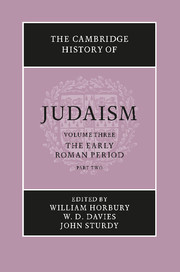Book contents
- Frontmatter
- 1 The archaeology of Palestine 63 bce–ce 70
- 2 The Herodian Temple
- 3 Recent archaeology in Palestine: achievements and future goals
- 4 The contribution of Jewish inscriptions to the study of Judaism
- 5 The social, economic and political history of Palestine 63 bce–ce 70
- 6 The Diaspora in the Roman period before ce 70
- 7 The Gentiles in Judaism 125 bce–ce 66
- 8 Gentiles as seen by Jews after ce 70
- 9 The synagogue
- 10 The Temple and the synagogue
- 11 The early liturgy of the synagogue
- 12 Women in the synagogue
- 13 The Pharisees
- 14 The Sadducees – their history and doctrines
- 15 The Essenes
- 16 The baptist sects
- 17 The troublemakers
- 18 The Samaritans and their sects
- 19 Galilean Judaism and Judaean Judaism
- 20 Jesus: from the Jewish point of view
- 21 Paul: from the Jewish point of view
- 22 Jewish Christianity
- 23 Apocalyptic: the disclosure of heavenly knowledge
- 24 The Qumran sectarian writings
- 25 The Dead Sea Scrolls and pre-Tannaitic Judaism
- 26 Prayer in the Qumran Texts
- 27 Philo of Alexandria
- 28 Josephus (ce 37–c. 100)
- 29 The rabbi in second-century Jewish society
- 30 The Hellenistic–Roman Diaspora ce 70–ce 235: the archaeological evidence
- 31 The legacy of Egypt in Judaism
- 32 Jewish elements in gnosticism and magic c.ce 70–c.ce 270
- Bibliographies
- Index
- References
14 - The Sadducees – their history and doctrines
Published online by Cambridge University Press: 28 March 2008
- Frontmatter
- 1 The archaeology of Palestine 63 bce–ce 70
- 2 The Herodian Temple
- 3 Recent archaeology in Palestine: achievements and future goals
- 4 The contribution of Jewish inscriptions to the study of Judaism
- 5 The social, economic and political history of Palestine 63 bce–ce 70
- 6 The Diaspora in the Roman period before ce 70
- 7 The Gentiles in Judaism 125 bce–ce 66
- 8 Gentiles as seen by Jews after ce 70
- 9 The synagogue
- 10 The Temple and the synagogue
- 11 The early liturgy of the synagogue
- 12 Women in the synagogue
- 13 The Pharisees
- 14 The Sadducees – their history and doctrines
- 15 The Essenes
- 16 The baptist sects
- 17 The troublemakers
- 18 The Samaritans and their sects
- 19 Galilean Judaism and Judaean Judaism
- 20 Jesus: from the Jewish point of view
- 21 Paul: from the Jewish point of view
- 22 Jewish Christianity
- 23 Apocalyptic: the disclosure of heavenly knowledge
- 24 The Qumran sectarian writings
- 25 The Dead Sea Scrolls and pre-Tannaitic Judaism
- 26 Prayer in the Qumran Texts
- 27 Philo of Alexandria
- 28 Josephus (ce 37–c. 100)
- 29 The rabbi in second-century Jewish society
- 30 The Hellenistic–Roman Diaspora ce 70–ce 235: the archaeological evidence
- 31 The legacy of Egypt in Judaism
- 32 Jewish elements in gnosticism and magic c.ce 70–c.ce 270
- Bibliographies
- Index
- References
Summary
THE SOURCES
Unlike the Pharisees and the Essenes, the Sadducees left no writings. Some scholars have thought to discover a Sadducaean tendency in First Maccabees, but it certainly cannot be considered a Sadducaean book. All the texts on the Sadducees at our disposal were written by their opponents or, at the least, by outsiders. They are necessarily selective and tendentious. Our main witness is Flavius Josephus who, being a scion of a high-ranking priestly family, might be expected to be close to the Sadducees or, at the least, to have inside information about them. He says that in his youth he tested the Sadducaean teaching and way of life, but his writings betray no special knowledge of them. He speaks of the Sadducees almost exclusively in connection with the other groups of the Judaism of his time.
The New Testament provides the earliest references to the Sadducees, in the Gospel of Mark. This gospel frequently names them among the opponents of Jesus, but it does not develop a coherent picture of them. For the New Testament, the Sadducees are entirely secondary to the Pharisees, who are represented as the main group of Judaism and the only important opponents of Jesus.
The Rabbinic sources frequently mention the Sadducees. But these texts have to be used with extreme caution: one has to discard those texts in which the term Sadducees replaces an original mín (which had to be removed because of Church censorship); only a few Tannaitic texts remain, and even they are not fully reliable historically; later texts display no specific knowledge of the historical Sadducees and offer clichés without revealing new information that can be trusted.
- Type
- Chapter
- Information
- The Cambridge History of Judaism , pp. 428 - 443Publisher: Cambridge University PressPrint publication year: 1999
References
- 3
- Cited by

